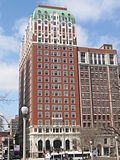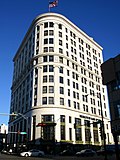Partners

Benjamin Howard Marshall
Benjamin H. Marshall (May 5, 1874 – June 19, 1944) was a native of Chicago. His formal education did not extend beyond his years at a private preparatory academy, the Harvard School, in then-suburban Kenwood. Impressed by the buildings being erected for the World's Columbian Exposition of 1893 near his south side home, the young Marshall decided on a career in architecture. At the age of 17, he became an apprentice in the firm of Marble and Wilson and two years later, at the time of Marble's death, he was named a full-fledged partner. In 1905, he established his own practice hiring MIT-trained architect and engineer, Charles Eli Fox.. [1] One of his earliest commissions was destroyed a month after its completion in an event remembered as one of Chicago's worst disasters, the Iroquois Theater Fire of 1903. [2]
Marshall's career was only temporarily affected by the disaster, and from 1905 to 1925, the firm of Marshall and Fox went on to build many of the most iconic structures in Chicago. His work was also part of the architecture event in the art competition at the 1928 Summer Olympics. [3] Marshall was handsome and wealthy and entrepreneurial, and he has been described as a cross between the fictional playboy Jay Gatsby and real-life showman Florenz Ziegfeld. Although not an original stylist, nor great structural innovator, he was a creative re-worker of style in popular building projects. After Fox's death in 1926, Marshall continued to operate the firm alone until his retirement in the 1930s when he was bankrupted by the Great Depression. He later moved into one of his buildings, the Drake Hotel, where he continued to design several of its interiors. [4]
Marshall designed and constructed an extravagant mansion for himself in Wilmette, Illinois. [5]
Charles Eli Fox
Charles Fox (July 1, 1870 – October 31, 1926) was born in Reading, Pennsylvania. After studying architecture at Massachusetts Institute of Technology he moved to Chicago in 1891. He was employed by the noted firm of Holabird & Roche, working primarily as a specialist in steel construction. The final 21 years of his career from 1905 to 1926 were spent in the partnership with Marshall. He was the firm's construction specialist and project manager.





